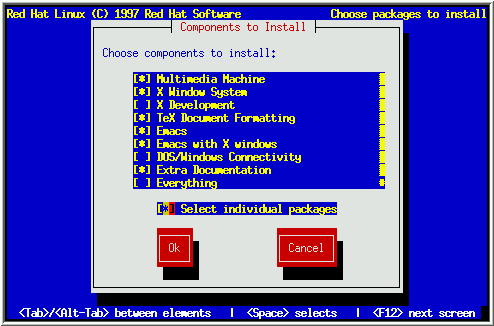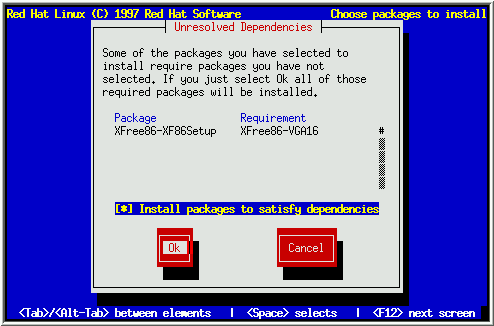
After your partitions have been configured and formatted, you are ready to select packages for installation. You can select components, which group packages together according to function, individual packages, or a combination of the two.
Components group packages together according to the functionality they provide. For example, C Development, Networked Workstation, or Web Server. Select each component you wish to install and press [Space]. Selecting Everything (which can be found at the end of the component list) installs all packages included with Red Hat Linux (see Figure 29).

If you wish to select or deselect individual packages, choose Select individual packages.
After selecting the components you wish to install, you may select or deselect individual packages. The installation program presents a list of the package groups available; select a group to examine and press [Enter]. The installation program presents a list of the packages in that group, which you may select or deselect using [Space] (see Figure 30). You may view a detailed description of a package by pressing [F1]. When you are finished selecting individual packages, press OK in the Select Group dialog box.

Please Note: Some packages (such as the kernel and certain libraries) are required for every Red Hat Linux system and are not available to select or deselect.
Many software packages, in order to work correctly, depend on other software packages or libraries that must be installed on your system. For example, many of the graphical Red Hat system administration tools require the python and pythonlib packages. To make sure your system has all the packages it needs in order to be fully functional, Red Hat Linux checks package dependencies each time you install or remove software packages.
After you have finished selecting packages to install, the installation program checks the list of selected packages for dependencies. If any package requires another package which you have not selected to install, the program presents a list of these unresolved dependencies and gives you the opportunity to resolve them (see Figure 31). If you simply press OK, the program will resolve them automatically by adding all required packages to the list of selected packages.

After all package dependencies are resolved, the installation program presents a dialog box telling you that a log file containing a list of all packages installed will be written to /tmp/install.log on your Red Hat Linux system. Select Ok and press [Space] to continue.
At this point, the installation program will format every partition you selected for formatting. This can take several minutes (and will take even longer if you directed the installation program to check for bad blocks).
Once all partitions have been formatted, the installation program starts to install packages. A window entitled ``Install Status'' is displayed with the following information:
If you're doing an FTP installation, a message box will pop up as each package is retrieved from the FTP site.
At this point there's nothing left for you to do until all the packages have been installed. How quickly this happens depends on the number of packages you've selected, and your computer's speed. Once all the packages have been installed, please turn to the next chapter to finish your installation of Red Hat Linux.